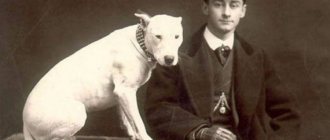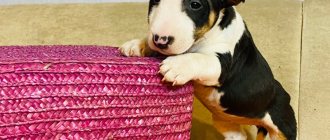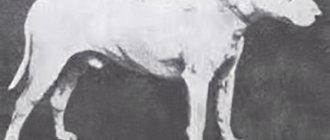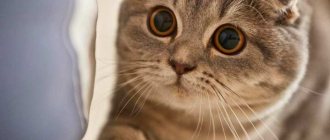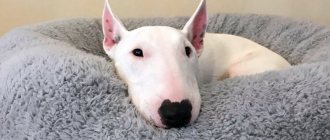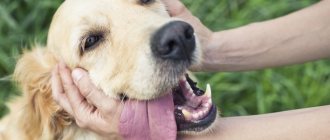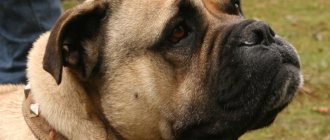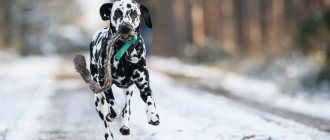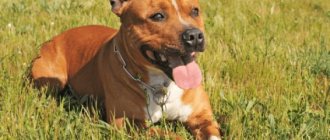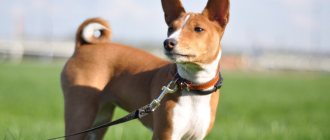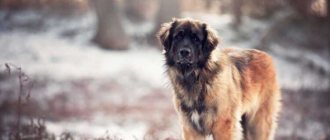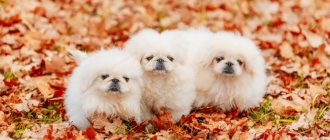We are sure that after reading the words “a dog with a rat face” in the title of our article, many of the owners of these animals will be offended by the author. After all, for them, their beloved four-legged friend is the smartest, most loyal and most beautiful. Perhaps someone sees similarities with the famous rodent - let's not judge them harshly.
Just recently, the domestic media presented the bull terrier as an evil, stupid, aggressive and extremely unattractive creature. At the same time, no one mentioned that sometimes the seemingly harmless Spitz, the cute Dalmatian or the charming Chow Chow are much more aggressive than the Bull Terrier, and that these dogs can be dangerous.
It all depends on the upbringing of the puppy, on what goal a person pursues when purchasing an animal. Some people need a loyal companion, while others want a killer dog next to them. Most often in our time, the latter category of owners includes teenagers who thus want to establish themselves among their peers.
But let’s leave emotions aside and try to figure out what she really is like – “a dog with a rat’s face.” Perhaps, after reading this article, someone will change their opinion about this animal.
Bull Terrier
In our country, this breed was popular in 1990-2000, but even now you can often find this unusual and somewhat strange-looking dog.
Non-fans often say that the Bull Terrier has a rat's face, but to me he seems like a sophisticated aristocrat, because the birthplace of the breed is England. A socialized and properly raised bull terrier is just a sweetheart, but if you raise him as a fighting dog, you get a real cyborg killer who feels neither fear nor pain. For a long time, a branch of bulls was bred in which their natural aggressiveness was eradicated. Therefore, when buying a puppy, you need to choose the breeder very carefully.
The Bull Terrier is a real fidget. He spins and turns, rushes around the house, the street - it doesn’t matter where. Therefore, he needs to be tired every day: take long walks and exercise him physically. If you don’t give him this, then your slippers, or even your sofa, will suffer. Therefore, it is undesirable for him to live in an apartment. He will bring too much chaos into it. If you leave a boule alone for a long time, then an unbearable howl will be added to the gnawed property, for which the neighbors will definitely say “thank you” to you.
The Bull Terrier perceives other animals either as a rival or as prey. There are cases of livability, but this is rare, and even in this case you should not leave your pets to their own devices. But bulls often do not show aggression towards people. Therefore, their guard is so-so.
Video: bull terrier
Description of the breed
Breeds that are used in fighting fall into a category called fighting dog breeds. There are approximately twenty breeds in the world that take part in this kind of competition. It should be noted that none of the International Canine Organizations recognize the category of fighting dogs. For them, this concept defines the profession, but not the breed of the dog.
The category of fighters has a number of common characteristics: a large head, a well-developed jaw, a massive body and a very menacing bark. A number of Molossians are classified in this category: Alabais, bulldogs, mastiffs, bull terriers and some varieties of Great Danes.
Alabai. A breed endowed with a complex psyche and a unique character. The use of Alabai as fighting dogs in Turkmenistan is a tribute to centuries-old traditions. The only breed that will never finish off an enemy, but will retreat at the first squeal. And, along with this, Alabai is surprisingly gentle and caring towards his own and human children. The main job of this devoted creature is to guard the peace of its owner in any weather and protect his property.
American Bulldog. Takes its roots from the English bulldog. Dogs with a powerful jaw and an iron grip. Initially, they were used for bull baiting, and later in fights against other dogs. Since the fighting qualities of dogs of this breed were not enough, they began to be crossed with various kinds of terriers. As a result of this work, a number of new breeds appeared, but not all of them inherited fighting qualities. And the American Bulldog himself has long forgotten his combat past.
American Pit Bull Terrier. Thanks to the negative media outpouring towards this breed, the pit bull was called the fiend of evil and an idol among fighting dog breeds, becoming the most dangerous creature in the eyes of the public.
In fact, they are one of the most cheerful, loyal and loving breeds on the planet. It simply contains an indomitable desire to please its owner in everything. This is the only breed whose feeling of love for a person is so great that it does not even notice the strong smell of alcohol, although almost all breeds simply cannot stand it.
American Staffordshire Bull Terrier. Another monster of the dog world, so colorfully described by the media. Let us only note that thanks to painstaking selection, the staff has lost its aggression towards living beings.
There are no dangerous breeds! There are very irresponsible owners. If you let upbringing take its course without training, you will definitely end up with a stubborn, unbalanced and disobedient dog. A dog becomes dangerous only with indifferent owners.
Group of fighting terriers
This is not a pure breed group. The word “terrier” itself is translated as “earthen” or “burrow”. The dogs were bred exclusively for hunting; they are small in size and cute in appearance.
As for fighting species, their ancestors are not only Terriers, but also world-famous Bulldogs. The breeds were actually bred for fighting, most often dog fighting. But in the mid-19th century, this entertainment became forbidden. Therefore, all such fighters were subject to selection work, during which the characters of the dogs were radically changed.
Now most of the former bloodthirsty dogs have become cute pets. However, fighting terriers are often used for service.
Bull Terrier
The shortest of the group, it reaches 30-40 cm at the withers and weighs 8-13 kg. These are small, stocky dogs with pronounced, well-developed muscles. A distinctive feature is an elongated convex skull and a round bridge of the nose, which gives the animal a terrifying appearance. A fighting feature is large teeth in a full set (42: 20 in the upper jaw and 22 in the lower jaw). Acceptable colors: white or colored (brindle, brown, red), spots are allowed.
The character of the Bull Terrier depends on heredity. Those who have never kept the breed often talk about the disadvantages. If the litter is of high quality and without deviations, then the puppy will develop normally, without outbursts of aggression or anger towards humans. Basically, Bullies are affectionate to their owners, love children, they are active and playful. Good physical shape makes them unsurpassed defenders; they treat strangers with caution, and with proper training they will never be the first to attack.
Among the minuses, it is worth considering jealousy, intolerance of loneliness, and cockiness. These pets will never miss an opportunity to show their leadership among other pets. To avoid this, you need to properly socialize the animal from the first days of training: introduce it to people, to tanks, and walk it in noisy places.
Animals are rarely kept outside; they are intended for apartment and home keeping. Due to their short fur, Bullies are susceptible to sudden climate changes and cannot tolerate severe frosts or abnormal heat. They are easy to care for, but require long walks and constant training.
Staffordshire Bull Terrier
A fighting breed bred from Molossian dogs, bulldogs and terriers for fighting. Breeders were in dire need of a compact, but strong and scary animal, as a result of which the Bull Terrier appeared. At the withers he is 35-40 cm and weighs 11-17 kg . Due to their small size, dogs were the best figures in dog fights held in closed pubs and restaurants.
Externally, Stafford is short, short-legged, but strong and muscular. The owners note that the animal can smile and be sad, this is due to the accumulation of wrinkles on the face and head. Dogs' ears are semi-erect, long, but not large. These Bulls look more like Bulldogs than Molossers.
Dogs have not been used as fighting dogs for a long time; their character has been completely changed to suit the desires of dog lovers. Therefore, Staffbulls are considered one of the most loyal and best family fighting dogs. They are companions rather than working service pets.
Dogs are loyal to their owner, love and protect children, and are non-aggressive towards people, even strangers . Genetically, Bulls may not like their brothers, but they are not aimed at eliminating the enemy. Representatives of the breed strive to demonstrate their leadership and establish themselves in the team through physical superiority.
Despite the fact that the breed is completely human-oriented, Staffbulls are often stubborn and try to take a dominant position in the house. They need serious education and physical activity, otherwise the animals are unpretentious.
American Pit Bull Terrier
Daughter breed of the Staffordshire Bull Terrier. It was developed in America after fight clubs for animals were banned in England. Bull Terriers were brought to the continent to improve their skills. As a result of selection, the Pit Bull Terrier, or Pit Bull for short, appeared.
The breed is characterized by extreme instability in appearance and growth. At the withers, individuals reach from 43 to 53 cm , resembling either bulldogs or terriers. A characteristic feature is a fit body and long muscular legs . The muzzle can be either short, wide or elongated. The color can be solid or brindle (except merle).
Despite its high popularity in America and the world, active use in the 19th and 20th centuries, the breed is still not recognized by the world canine organization. Dogs do not have a clear standard; breeding, to a large extent, is carried out randomly. This is why Petes can differ greatly in appearance and character.
Pit bulls are the most aggressive and uncontrollable of the fighting terrier group, all because the development of character is difficult to keep track of. Not every nursery has family books, so it is difficult to analyze the shortcomings of a particular puppy’s ancestors. Dogs are prohibited in many EU countries and America. Other states have introduced strict rules for keeping and walking the breed, because it is classified as potentially dangerous.
In fact, healthy adequate Pit Bull Terriers do not have aggression towards humans. Their anger is directed at animals, in particular dogs. Well-mannered Pete will be affectionate and friendly even to strangers.
American Staffordshire Terrier
American Staff or Amstaff is a breed branch originating from the Pit Bull. Unlike their brothers, Amstafs are registered and recognized by the world. They have a softer character, although they are still not as kind as Staffbulls. Their direct goal is to protect themselves and their owner, and eliminate the threat.
They are similar in appearance to Pita: long-legged, tall (43-48 cm), strong and muscular. However, their type is terrier. The muzzle is not wide and elongated with a deep stop and a minimum of wrinkles. Unlike Staffbulls, Staffies' ears are cropped. In addition, this breed cannot have white, liver or tan colors.
By character, Amstaf is a true leader, a winner . Animals are hardy, strong, with a high pain threshold and a strong nervous system. They show good results in training and are better suited than others for service in military structures. Dogs are friendly to people, although strangers should stay away from them.
Dog with a rat face breed photo ⋆ Online magazine for women
The Bull Terrier breed has received a special status - it is called “the dog with a rat face.” With its appearance, it caused conflicting opinions in the world community. She was prescribed the characteristics of a killer dog and at the same time she was considered a reliable friend and guard.
Origin story
The founder of the breed is the Englishman James Hinks. Thanks to him, experimental fighting dog puppies with an elongated rat muzzle were born. The exterior of bull terriers was formed as a result of 10 years of crossing the extinct breed of white terrier and English bulldog, with admixtures of Dalmatian blood.
The main goal - to get a fearless dog with a high pain threshold - was achieved. The beauty and aesthetics of the animal’s external appearance were not considered.
At the end of the 19th century, the breed was recognized by the English Kennel Club. At the beginning of the 20th century it was allowed to reproduce. Keeping a bull terrier has become a prestigious occupation that emphasizes social status.
Bull Terrier - description
Previously, this breed of dog was used for baiting wild animals and dog fighting. Since the ban on bloody spectacles, the breed has come a long way of socialization and managed to adapt to the requirements of modern people.
The Bull Terrier today is a loyal friend, a cheerful companion and an active athlete. Myths about its mortal danger have been dispelled. He is the embodiment of intelligence, endurance, strength and dexterity. His extraordinary appearance makes him look like a giant rat. The photo of a dog with a rat's face confirms this.
Bull Terrier - a dog with a rat face
Breed standard
The Bull Terrier has an international breed standard, deviations from which are considered a fault:
- The body is athletic, muscular, strong.
- The head is oval, ovoid in shape.
- The muzzle is elongated, arched.
- The neck is strong.
- The jaws are powerful, the compression force is 25 atmospheres.
- The mouth is big.
- The bite of the teeth is cross-shaped.
- The ears are erect, V-shaped, close set.
- The nose is pronounced and large.
- The eyes are small, triangular in appearance, slanted, wide and deep set.
- The tail is short and not docked.
- Average weight 30 kg, not limited by standard.
- Height at withers is from 40 to 55 cm. Males are larger than females.
- Life expectancy is 12-14 years.
Character and education
The nature of the “boules” is specific. They have an extraordinary mind and can read a person’s thoughts. From the first days, it is necessary to extinguish the foci of their aggression and direct the strength and energy of the dogs in the right direction. With proper upbringing of a puppy and its early socialization, a good friend and protector will grow up.
Bull Terriers are hyperactive and require long-term physical and mental training. They are willful and stubborn. They are not characterized by cowardice and betrayal. Ready to protect the owner at the cost of life. Affectionate in the family, loyal to children and powerful in the world around them. Any representatives of the fauna are treated as prey. Walking without a leash is prohibited.
Training
Training a Bull Terrier requires a lot of time and effort. To achieve results, strict and humane methods are needed. Physical punishment is prohibited; the bull remembers insults. These dogs need the strong-willed hand of a competent breeder. Otherwise, you can get an uncontrollable and dangerous animal.
Care and maintenance
In terms of grooming, the Bull Terrier is not difficult, he is clean:
- Brush the coat with a rubber mitten 2-3 times a week, daily during the shedding period.
- Clean your ears once a week.
- Wash your eyes daily.
- After walking, wipe with a damp towel.
- Bath with shampoo as needed.
- Trim the claws.
exclusively domestic, preferably to a family without children. Aviary and chain housing breaks the animal’s psyche and leads to its aggression. The bull is afraid of the cold; at temperatures below -10, walk in clothes. During the hot season, refrain from exposing your pet to the sun.
Diseases
High-quality representatives of the breed have strong immunity. Hereditary diseases include:
- partial or complete deafness;
- loss of vision;
- kidney diseases.
Other diseases arise due to poor care and maintenance (dermatitis, heart failure, pancreatitis).
Origin of the Bull Terrier breed
The homeland of the Bull Terrier breed is Great Britain. For the first time, dogs with an elongated, rat-like muzzle appeared in the middle of the 19th century as a result of many years of experiments. To create the breed, English bulldogs, white English terriers and Dalmatians were crossed. From all these breeds the dog has adopted the best traits - endurance, activity, courage, intelligence.
Four-legged sumo wrestler
Tosa Inu is heavy, fearless, and feels little pain.
It has a height at the withers of up to 60 cm, weighs 40-80 kg. They appeared at the end of the 19th century as a result of crossing a local dog used for hunting wild boars with European ones. Selective selection has been carried out for many years in order to obtain a dog with the best fighting qualities. , having the strength and weight of a mastiff, is very agile and resilient. This animal has a very strong and independent character, constantly striving to prove its dominance, so the dog is recommended only to those who have the skills to communicate with fighting dogs.
An improperly raised puppy will grow up to be an aggressive dog with unpredictable behavior. Tosa Inu are prohibited in Norway and Denmark.
Usually, a pit bull easily changes owners, especially if it finds itself in better conditions.
In Japan, Tosa Inu dogs are permanent participants in popular fights that take place in special premises where the animals are also bred and trained. Dog fighting in Japan is a civilized spectacle with its own rules and regulations. The main thing is that bloodshed and injury are not allowed here: a fighter who barks, bites, and wounds an opponent to the point of bleeding, will be disqualified forever. Only males take part in battles. The winner is the one who knocks the enemy down and crushes him with his weight. Tosa Inu fights silently, without growling. In terms of spirit, courage and endurance in the ring, Tosa Inus are compared to sumo wrestlers and are also awarded champion titles.
Tosa Inu fighting dogs are loyal to their owner and very intelligent. They are used for security, in search and rescue operations and in therapeutic canine therapy.
The complex nature of the Bull Terrier requires a gentle, patient and consistent attitude
Breed standard Prague rat
The Prague Rat is a miniature “aristocrat”, at first glance it looks a lot like a Russian Toy and a little less like a Miniature Pinscher. Breeding specialists attach great importance to the body proportions of ratliks, so they have to identify an exemplary representative of the breed, armed with a measuring tape and a calculator. In particular, the ratio of the dog's height to the length of its body should be about 1:1.05. Moreover, the figure indicating the height of the animal at the withers must be at least twice the depth of its chest, measured in centimeters. The width of the rat's forehead in relation to its length is 1:1, less often – 1:1.03, and the length of the muzzle does not exceed ½ the length of the head.
Head
The Prague rat's head is pear-shaped. The occipital protuberance and forehead of the dog are convex, clearly defined, the stop is moderately prominent. The animal's muzzle is distinguished by its general dryness and sufficient length.
Teeth and jaws
The ratlik's jaws are strong, symmetrically set, and shaped like a blunt wedge. A full dentition and scissor bite are preferred.
Ears
Representatives of this breed have wide-set, strong ears, fixed in a standing position and shaped like butterfly wings. It is acceptable, although not very desirable, for the tips of the ear flaps to be lowered at a slight angle to each other.
Frame
The body of the Prague rat is compact, almost square in format, with a moderately selected underline. The back is level, strong, with unpronounced withers and a short loin. The dog's chest is oval and of normal width. The croup line is long, slightly sloping.
The front legs are set parallel and quite wide. The Prague rat's shoulder blades are muscular, well-fitting, the pasterns are even, set at a slight angle. The dog's hind legs are distinguished by a wide, parallel stance, reliable articulation angles and overall muscular contours. The paws of representatives of this breed are rounded, arched, with tightly clenched toes. The dog's movements are free and springy.
Tail
The tail of the Prague rat rat is set at the level of the back, but when moving it rises higher, curling into a ring. The usual length of an undocked tail is to the hocks.
Wool
Prague Rat Dogs can be either short-haired or semi-long-haired. In the first case, the dog’s body is dense and fits well to the body. Secondly, it is softer, slightly behind the body, forming stylish feathering on the paws, ears and tail.
Color
Most Prague rats are black or brown and tan, and the tan should have a rich tone and not be washed out. Typical locations for tan marks are the pasterns, throat, cheeks, eyebrows, inner thighs and chest (spots in the form of two symmetrical triangles). A little less often you can find representatives of this breed of sand and chocolate colors. A marbled coat tone is also acceptable.
Defects and disqualifying defects
The most typical exterior defects of the breed: narrow skull, pincer bite, convex loin and back, depigmented nose, excess tan. White spots on the chest with an area of more than 1 cm, elbows turned in or out, an overly stretched body, a low-set tail that hangs over one of the hips are also not welcome.
Disqualifying vices of Prague rat rats:
- not completely overgrown fontanel;
- hair with receding hairline;
- hunchback and overly convex lower back;
- ears adjacent to the skull;
- undershot/overshot;
- iris of the eye, colored yellow or blue;
- loss of 4 teeth or 2 incisors;
- black and brown and tan individuals have no tan markings on the head;
- a white spot on the chest with an area of 2 cm, white markings on the paws;
- red color, muted by abundant black blossoms;
- height less than 18 and more than 24 cm;
- unreasonable aggression and fearfulness.
Jagdterrier
Nobility and courage are about them.
- Height: 33-40 cm for a male; 28-35 for a female
- Weight: 8-10 kg.
- Lifespan: 13-15 years.
- Color: black, dark brown or grey-tan.
- Coat: medium length, thick. Densely laid over thick undercoat.
Did you know? In 1995, a “dog” record for the length of the swim was set. Labradors Gypsy and Kai, accompanied by their owner, swam 15.2 km (it took 6 hours).
They are easy to train and train, which should be done regularly. Long walks with elements of play (bring a stick or ball) are required, without which the dog will become lethargic or show destructive tendencies.
This terrier will get bored in an apartment, so it is better to keep it while living in your own home. By the way, children will not be the best companions for them (although dogs accept them as “their own”, rushing to help if necessary).
Favorite location is a field where you can chase trophies without restraint, which often ends in a direct fight (brave “yagdas” are not afraid to attack).
Character and education
The nature of the “boules” is specific. They have an extraordinary mind and can read a person’s thoughts. From the first days, it is necessary to extinguish the foci of their aggression and direct the strength and energy of the dogs in the right direction. With proper upbringing of a puppy and its early socialization, a good friend and protector will grow up.
Bull Terriers are hyperactive and require long-term physical and mental training. They are willful and stubborn. They are not characterized by cowardice and betrayal. Ready to protect the owner at the cost of life. Affectionate in the family, loyal to children and powerful in the world around them. Any representatives of the fauna are treated as prey. Walking without a leash is prohibited.
Let's sum it up
Representatives of the Bull Terrier breed can be briefly described in a few words: strong and dexterous, wise and sociable, loyal and kind. These dogs require early socialization and mandatory training. Suitable for experienced and active owners. You need to know that the bull terrier, like many other dog breeds, will not perceive a nervous and insecure person as a leader, as well as a cruel, offending animal. This dog will submit and respond to care and love, and will be devoted only to those he respects, and such respect must be earned.
Character
There is a misconception about pets of this breed. This rat-faced fighting dog is believed to have a very aggressive disposition. However, this is not the case. By nature, bull terriers are very cheerful, affectionate and loyal. These dogs hate being alone, so they prefer to always be in company. They love to play with children, and anger towards people is absolutely abhorrent to them.
There are probably only a few situations where their stereotypical nickname can be justified. So, when two males meet head to head, each of them begins to want to defend the right to be the leader of the pack. As for females: two or more can easily get along in one company, just like, in principle, a female and a male.
Also, bull terriers are fighting dogs, which means they have a desire to win in their blood, so when they see cats and other living creatures, they can lose control of themselves. As a result, keeping two different pets in the house becomes a very risky decision.
Sometimes, due to their nature, Bull Terriers can try to insist on their own, but with proper training they become obedient companions.
Thanks to the strength of the Bull Terrier, dogs are excellent running partners and other sports activities.
Origin story
This breed is very similar to a rat. Seeing it live or in a photo, you might think that this is really a mutant rat. And because of this, many believe that its homeland is Asia. Why Asia is associated with rats is not clear. But, in fact, the bull terrier breed appeared in England, back in the 60s of the 19th century.
The bull terrier was created by James Hinks. His goal was to develop a white fighting breed that would not have any disadvantages. These results were achieved by selecting the English Terrier, Dalmatian and English Bulldog. In 1862, this was successful and a purebred, new breed appeared - the bull terrier.
It is worth noting that many people confuse the breed and call it the American Bull Terrier. There is no such breed at all, there is an American pit bull terrier, a Staffordshire bull terrier and just a bull terrier.
How to keep and care for a Bull Terrier
The breed is a smooth-haired dog, so you won’t need any complicated care. Your pet may shed twice a year. Wool can be easily removed with a brush or a special mitten.
After walks, you don’t need to bathe your dog; just wipe it with a sponge or damp towel.
Check your ears and eyes regularly for inflammation. Whites may have hearing problems. There are cases when puppies are born deaf.
The Bull Terrier's mobility indicates that it really needs to be exercised. Therefore, active walks, playing with a ball, jumping over the bar - all this is necessary to maintain the good physical condition of the dog. After such walks, the dog will be calm and docile. And with insufficient loads, don’t be surprised why he goes crazy and turns everything upside down.
Dog food
What to feed a bull terrier? Such a powerful, muscular and energetic dog must be well fed. It is best to opt for specialized food with a balanced composition, which contains the required amount of proteins and carbohydrates, vitamins and microelements.
Contrary to popular belief, you should not feed your Bull Terrier only meat. The daily diet should contain the following products:
- 60% meat;
- 20% cereals;
- 20% vegetables.
In addition to beef and chicken, it is allowed to feed your pet sea fish fillet and offal. You can also give fermented milk products: sour cream, cottage cheese.
Gampr (Armenian Wolfhound)
This breed is quite large and looks powerful, its height is about 64-68 centimeters, but there are specimens that are about 90 centimeters. The dog's weight varies between 49-64 kilograms, a significant part of it falls on the wool. The muscles are well developed, the body is quite massive, the chest is wide. The ears hang down, the eyes are dark, there are sloping brow ridges, making the look look friendly. The color of this breed varies, most often it is sandy, but the muzzle is always black or gray. The coat is long, the tail does not lie on the back even in a state of excitement.
Gampr is a kind and caring dog, she does not like fuss and clearly follows commands. She usually shows a reverent attitude towards children and remains neutral towards other animals. The dog behaves calmly during training and appreciates encouragement.
to contents ^
Exterior
Compact, small dogs do not exceed 32 cm in height. Since the beginning of the 20th century, griffons have been divided into two weight categories:
- Up to 3 kg;
- 3.5 – 6 kg.
The griffon is shaped like a square. A characteristic feature of the breed is a large head relative to the size of the body and an expressive muzzle. In a “flat-faced” dog, the nostrils are almost at eye level. Widely spaced round eyes are dark in color. The ears are small, cropped and undocked ears are allowed. The tail is usually docked, with the undocked tail carried upward.
See also: American Eskimo Spitz
The elegant Belgian Griffon is a black dog (photo). Color with tan marks is allowed. Griffon dogs' fur is hard, slightly wavy, and tousled; there is undercoat. The hair above the eyes and on the cheekbones is longer and forms the eyebrows, mustache and beard.
Raising a puppy
The Bull Terrier is a hyperactive dog, so you need to start training your puppy from the first days of his arrival in your home. The new resident should have a place to rest, a designated place for food, where there should be bowls for food and water.
View gallery
First of all, the owner must make it clear to the baby that he is the master of the house. You cannot follow the puppy’s lead, allowing him to climb onto the sofa or beg at the master’s table. Small bull terriers are very smart. They quickly understand that they cannot take food from strangers or pick it up from the ground, etc. If you understand that you cannot raise a puppy on your own, contact a professional dog trainer.
Bloodhound
The Bloodhound “sees” the world primarily with its extremely sensitive nose. These dogs are difficult to train because they are constantly distracted by all the smells around them. They also have a ton of energy, stubbornness and determination, and are absolutely unstoppable once they get on the scent trail. It is unlikely that you will be able to force a Bloodhound to do anything against its will. But on a large plot outside the city, where the dog can move freely, your pet will be happy, cheerful and satisfied with life.
Dogue de Bordeaux
Despite its massiveness and healthy appearance, this is a sickly breed that requires regular preventive examination by a veterinarian. A healthy and caring Dogue de Bordeaux will become a faithful companion and reliable protector.
Curiosity and activity are qualities that are not characteristic of this dog. He almost always behaves with restraint, concentration and calm. There is little that can provoke him into a strong display of emotions.
If a stranger comes into the territory of the Dogue de Bordeaux, he begins to bark loudly, thereby attracting the attention of his owner.
Despite the lack of excessive activity, you should not put your dog on a chain. This will make her unhappy. She really needs to communicate with her owners and loves scratching and other tactile contacts.
The appearance of the animal is unusual. It has thin red fur, drooping cheeks, long floppy ears and a wide mouth. Due to the large number of skin folds on the face, the dog looks sad.
Dogue de Bordeaux is ideal for owners who lead a sedentary lifestyle and prefer to spend most of the day lying on the couch with their beloved pet.
German Shepherd
German Shepherds, bred for working and guarding purposes, are very intelligent and confident dogs. Their long noses and naturally erect ears are classic characteristics of this versatile breed.
German Shepherds, which often become highly trained working and police dogs, require precision and consistency from their owners during the training process.
How to keep and care for a Bull Terrier
A dog with a hooked nose, like other pets, requires proper care. In spring and autumn there is heavy molting. At this time, you need to pay more attention to combing, which requires a special brush and a rubber mitten. During other periods, the frequency of combing is 2-3 times a week. The pig-faced fighting baby needs to eat regularly to gain energy.
Hygiene procedures should be carried out regularly. They are as follows:
- you need to clean your ears every week;
- trim nails regularly;
- wash your dog with special shampoo as needed;
- Rinse your eyes daily, otherwise inflammation may develop.
The Bull Terrier needs active walks, games with a ball and sticks. Due to its short fur, the dog cannot tolerate extreme cold. Therefore, you need to wear special clothes. In summer, it is recommended to spend more time in the shade.
Note! Bull Terriers extremely rarely suffer from ear diseases, but problems with hearing can occur, especially in white individuals. Many are born completely deaf
Summer walks should be active. Therefore, it is recommended to lengthen the leash when your pet is walking in the park. You need to purchase a sufficient number of toys: balls, rubber bones, flying saucers. If the walk is less active, the dog will be nervous and take out its energy on things in the house.
This dog must be trained using only humane methods. If you use physical force, there is a possibility of provoking aggression. Do not forget that the dog has a fighting spirit. At the same time, training takes a lot of time and effort, and it is often carried out exclusively by a specialist. The pet must understand that the owner must be in charge, only in this case will he unquestioningly fulfill all requirements.
Nutrition
A powerful and muscular dog requires a lot of energy. Therefore, due attention should be paid to creating a daily diet. Recommendations for nutrition are as follows:
- Dry food with a balanced composition is best suited. They contain the proper amount of carbohydrates, microelements and vitamins.
- A strange superstition concerns that a dog should be fed exclusively meat. Experts recommend including 20% cereals and 20% vegetables in your diet.
- Most often, beef and chicken are chosen as the main food. In some cases, it is possible to add sea fish fillets. You can add cottage cheese and sour cream.
The puppy is given his own daily diet. In most cases, it is represented by special food that is rich in useful microelements.
Bull Terrier nutrition
Useful tips
Since rat-faced dogs have very colorful genetics, they require proper care and supervision.
It has been said more than once about the physiological characteristics of the breed, because bull terriers definitely need constant physical activity. If there are not enough of them, the pet begins to look for other outlets for energy, which affects the character of the animal. Another extreme that a lack of exercise can lead to is laziness and, as a result, a gain in fat mass.
For good moral health, the pet must feel that he is loved and important, but at the same time, care should be taken to ensure that the bull knows who remains in charge in the house.
The rat-faced fighting dog is just as possessive as its terrier cousin. Therefore, teasing an adult should not only not be done, but is completely prohibited. Behavior in the form of taking away toys and claiming his property will cause a flurry of justified aggression in the dog.
From a very early age you should:
- to accustom him to the fact that everything around him belongs not only to him;
- show your dissatisfaction with all your appearance when the puppy has an outburst of aggression;
- do not indulge your pet’s whims;
- reward a completed command with treats or verbal praise;
- if the command fails, do not pour a mountain of abuse on the bull, and especially do not physically harm him.
If the owner has a balanced character and a persistent disposition, he has every chance of raising a safe pet both for the home and for society.
Bandog
The American Bandog was originally bred specifically to participate in battles, but later it was retrained as a watchman. Breeders got the dog by crossing a Neapolitan mastiff with a Staffordshire terrier. The name of the breed literally translates as “chain dog.”
The height of the dog at the withers is no more than 73 cm. The physique is muscular and strong. Bandogs have a capricious character. If the pet is not in the mood, then he will not allow household members to play with him. He treats family members with restraint and recognizes only the owner. He will not forgive children for pranks, so it is highly not recommended to keep him in a house where children live.
In battles, the dog showed rapid fatigue, which is why it was almost immediately stopped being used as a fighting dog. The peculiarity of this purebred dog is that during a walk he may have a desire to protect the strangers around him.
Bull Terrier – Gladiator in a White Tailcoat
England is considered the birthplace of all rat-faced dogs. This breed was developed by James Hincks. Back in the 19th century, he introduced everyone to a white dog with an ordinary appearance. After some time, a fighting bull terrier of a different color appeared. Several completely different breeds took part in the selection:
- English bulldog;
- Dalmatian;
- white English terrier.
Bull Terrier dog
For many years it was believed that keeping a house of this breed was a sign of good taste. The rat-like dog was a huge success among almost all dog breeders in England. The breed standards are as follows:
- muscular torso;
- height up to 55 cm;
- weight up to 30 kg;
- long elongated head with a shark mouth;
- powerful jaws;
- small tail;
- a big nose.
The color can be varied, but most attention is paid to white wool. A dog with a muzzle like a rat, despite its muscular build, has sufficient agility and can jump high
Head structure
Almost immediately, a dog with a rat's face catches the eye due to the unusual egg-shaped head. Many people find her attractive. The features are as follows:
- the muzzle immediately catches the eye due to the powerful jaw, the teeth are very strong;
- the head is set low on a muscular and strong neck;
- The ears are triangular and erect. They are located quite close to each other;
- the nose is large. Many people argue that a dog with a long nose resembles a rat and is therefore unattractive;
- The eyes are very small and set wide apart, which is why many people think that the dog looks like a pig.
Note! A pit bull with a sharp muzzle is not an elegant dog. The dog's habits look unusual due to its massive body and interesting face.
Coat and colors
Pit bull terriers or pit bulls must be white in color according to the standards. Skin pigmentation largely determines a dog's attractiveness. In addition, wool can be of other shades:
- red color without any markings. In this case, shades can differ significantly, even dark brown;
- black color is less common than others;
- Two-color bull terriers differ from others in that they have large areas of contrasting color. There are a variety of combinations, for example, black and red. White patches spread over the face, paws or chest. Ideally, they should account for no more than 50% of the color;
- There is also a three-color color variant. It is represented by a combination of black, red and white. In most cases, a black tint predominates; white should be no more than 50%. The red color accounts for the least, it appears on the muzzle or chest, as well as on the limbs.
- brindles were not immediately recognized, but eventually they began to be considered at exhibitions. The color of such a dog is represented by a combination of red and dark stripes. In some cases there are white markings.
Body type
Dog with folds: wrinkled pet breed
When examining a dog with a pig's muzzle, what immediately catches your eye is that it has a powerful and muscular body and a rounded chest.
The limbs are muscular and strong. With a massive body, the pit bull pig is very agile and agile. The peculiarity is that the dog has strong jumping ability. The fighting pet constantly runs around due to the large amount of energy.
Bull Terrier Body Type
